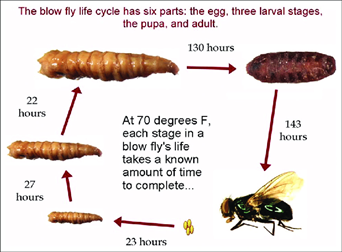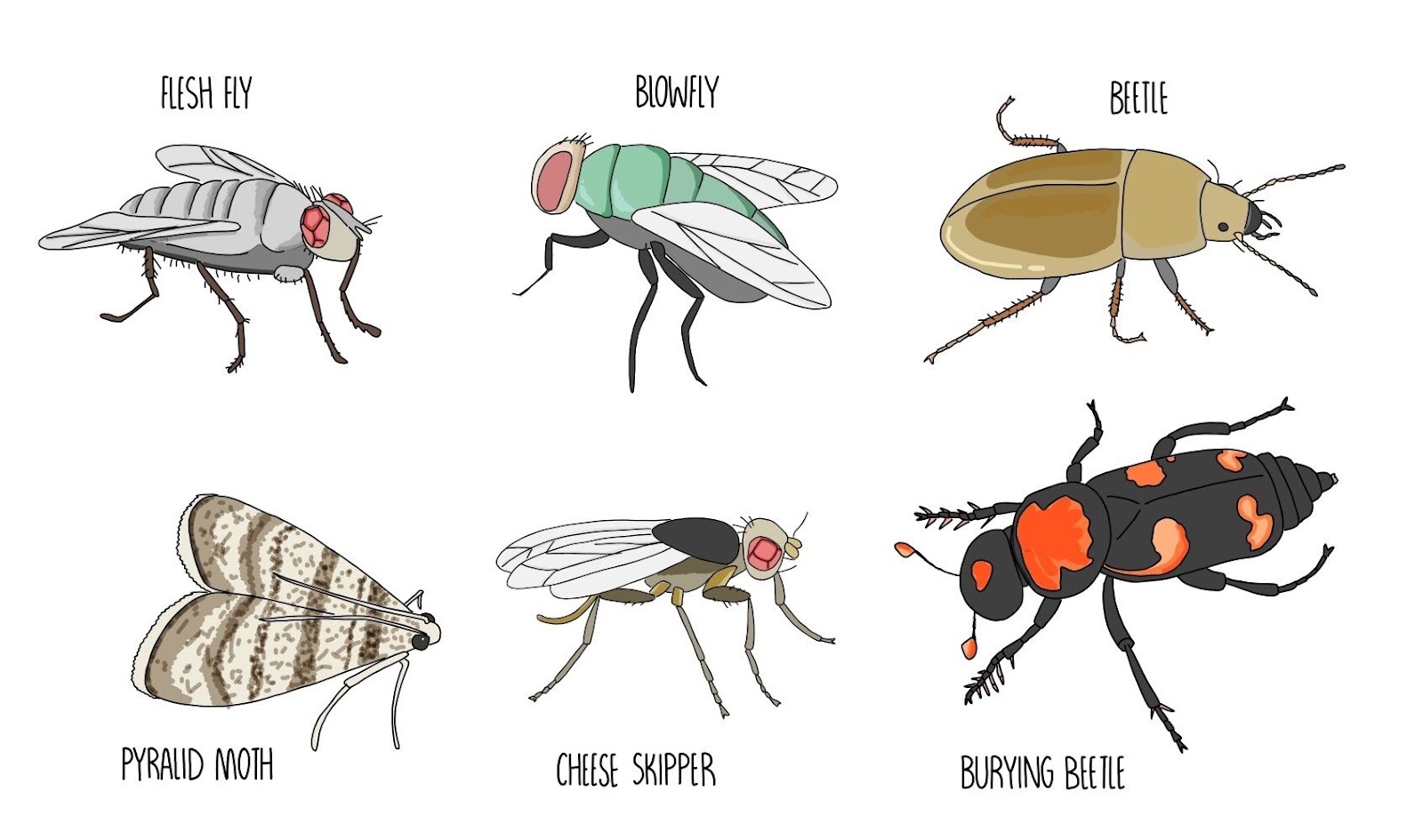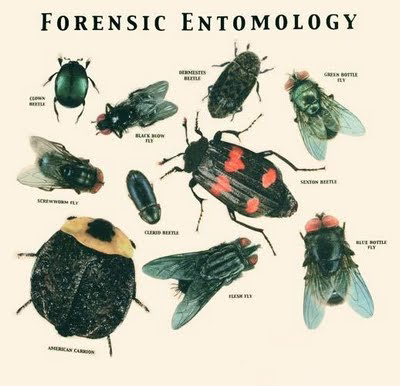Introduction
Forensic Entomology plays a significant role in the investigation of deaths. It is a branch of forensic science that deals with the study of insects for forensic analysis.
What comes to your mind when you hear the word ‘insects’?
The unavoidable creepy, crawly creatures that have always been the patrons of hate and loathe, isn’t it? Insects have always been unwanted on the face of the planet, at least for plebeians like us.
But did you ever wonder why Forensic Scientists have a different level of regard altogether for insects?
These ubiquitous creepy-crawlies actually contain a profound source of vital information for forensic investigators probing serious cases such as murders, accidents, natural deaths, and sexual assaults.
So what is Forensic Entomology? And how are insects used in Forensic Entomology? You will find out in the following sections.
Forensic Entomology - Definition
Forensic Entomology is the application of zoological principles for gaining forensic insights. Study of insects and other arthropods found on and near a cadaver are crucial to estimating the post mortem interval. Post mortem interval i.e. the time that has elapsed since the death of a living being is vital in probing the death of humans and animals.
Post mortem interval is estimated by a scientific evaluation of the insects present at the scene and on the body. It also requires a thorough examination of the environment in which the corpse is found to study the succession patterns of the insects.
Forensic Entomology is particularly useful for conducting forensic investigations in legal and criminal cases. Although it is mostly applied for investigation of a death, it is also helpful in detection of drugs and poisons, determination of the location of an incident and estimation of the time of infliction of wounds.
History of Forensic Entomology
The first instance of insects’ use in Forensic Entomology was in ancient China when a local farmer was found hacked to death.
At a time when forensic science was still in its formative years, all that investigators had was an understanding of the basic principles of the science. This led to the investigators actually inflicting wounds from multiple weapons on an animal carcass.
On comparing the wound with the one on the victim it was conclusive that it was caused by a sickle. Since a sickle was most likely to be used by a peasant, the local magistrate asked all suspected local peasants to gather with their sickles.
The peasant who had assembled at the town square were asked to lay their sickles on the ground. While most stood unaware, the magistrate for sure knew what was in store for the spectators and the guilty!
Primitive Forensic Entomology
As the sickles lay on the ground, bright metallic green flies began gathering over the village square.
Eventually, they started swarming over one hand sickle in particular. This was sufficient for the peasant owning that sickle and the entire village to perceive who the guilty really was.
The metallic colored flies were blow flies that are naturally attracted to the soft tissues, blood, and bones of dead bodies. This was the very first case in the history of forensic science when forensic entomology was used to convict the guilty and serve justice.
Subsequently, forensic entomology and the way insects are used for investigations have evolved significantly lending deeper insights to forensic scientists.
Evolution of Forensic Entomology
Francesco Redi, an Italian physician, refuted the theory of spontaneous generation in 1668. At that time, the incumbent theory was that maggots developed spontaneously from a rotting piece of meat. However, Redi could prove through a series of experiments that it was only when meat was fully or partially exposed to air that it developed fly maggots.
The discovery that maggots did not develop on rotting meat that was not exposed to air brought huge revolution in the world of forensic entomology. It spurred further analysis of insect life cycles and forensic entomology as a whole.
Insects Used in Forensic Entomology
So here’s breaking the mystery. How can something as despicable as insects lend such crucial information to forensic investigators? The following section shall reveal how are insects used in forensic entomology.
Flies:
Flies are among the first insects that are attracted to a corpse. Their offspring, maggots, feed on moist cadavers. Following are the flies that are relevant to forensic entomology.
1.Blow Flies: Blow flies are the ones that have mentioned in the first record of the application of forensic entomology in Song Ci’s book. These metallic looking flies have the ability to smell decaying flesh from up to 16 km away. That’s called as having some real olfactory senses!!
2.Flesh Flies: Flesh flies mostly breed on decaying corpses, garbage, dung or any other decaying material. A few species, however, lay their eggs in the exposed wounds of mammals. Being viviparous in nature, flesh flies often give birth on decaying human and animal corpses.
3.House Flies: They are the most common type of flies and are the carriers of serious diseases as we are all aware!
4.Cheese Flies: These flies are mostly found in animal products and fungi. Their larvae most infest smoked fish, cured meat, cheese and decaying animals. The presence of cheese fly larvae is crucial for estimating the time of death for humans.
Beetles:
Beetles generally infest a corpse in the later stages of decomposition compared to flies. Beetles are replaced by moth flies in drier conditions.
*Dermestid Beetles: Also called as skin or hide beetles, they infest a decomposing cadaver only once the soft tissues have been devoured by other organisms. They thrive on the skin and hair and are one of the most common insects collected by forensic entomologists from human corpses.
*Bone Beetles: These are also collected from corpses in the later stages of decomposition. Beetles belonging to this family (Cleridae) feed on decaying flesh, leaving the skeletal remains immaculately clean!
*Carrion Beetles: The larva of carrion beetles are known to thrive on vertebrate carcasses while the adults devour maggots. These chaps are quite a patron of social service as they have a tendency to dig and inter small carcasses underground.
*Hide Beetles: These feed on decaying carcasses and dry animal products such as bacon, dog treats, dried fish, cheese, and They usually form clusters around resources where feeding and mating are likely to happen.
*Rove Beetles: Rove beetles are different from carrion beetles in a way that they feed on cadavers or carcasses and not on decaying flesh (carrion). They thrive on maggots and other insect larvae present on carrions.
*Scarab Beetles: Scarab beetles belong to the Scarabaeidae family that also includes dung beetles which are generally found on or under carrion and corpses. They feed on fungi, dung or decaying flesh and act as a cleanup crew for the animal kingdom.
*Sap Beetles: These beetles are mostly found near fermenting or decaying plant fluids such as rotting melons or tree sap. Some sap beetles though infest carcasses also and are very crucial in forensic entomology.
*Clown Beetles: Also known as Hister beetles, these beetles are smart players. They usually hide under the carcass during the day to emerge at night and feed on maggots or dermestid beetle larvae thriving on it.
*Dung Beetles: These beetles thrive and feed on carrion. Their larvae feed on decaying fungi, manure and vertebrate carcasses at any stage of the decomposition.
*Mites: Macrocheles mites feed on carcasses in the early stages of the decomposition whereas Tyroglyphidae and Oribatidae mites thrive on dry skin later in the decomposition process.
*Moths: The larvae of moths that are active primarily during twilight and daytime feed on the hair of mammalian corpses and are amongst the last animals joining in the decomposition of a corpse.
Application of Forensic Entomology for Investigations Other than Death
#Food Infestation Cases: Food production facilities where Integrated Pest Management procedures are not followed can be quite enticing for pests. Cases involving the contamination of food products with insect debris call for the involvement of a forensic entomologist to investigate and provide litigation support.
#Presence of Drugs: An analysis of the bodies, feces and dead skins of insects feeding on carrion and cadavers helps forensic entomologist determine the presence and type of drugs or poison in the body.
#DNA Extraction: Blood-sucking insects consume blood that makes it possible for a forensic scientist to use it for extraction of DNA. This is helpful in cases where the assailant leaves a bite-mark evidence.








